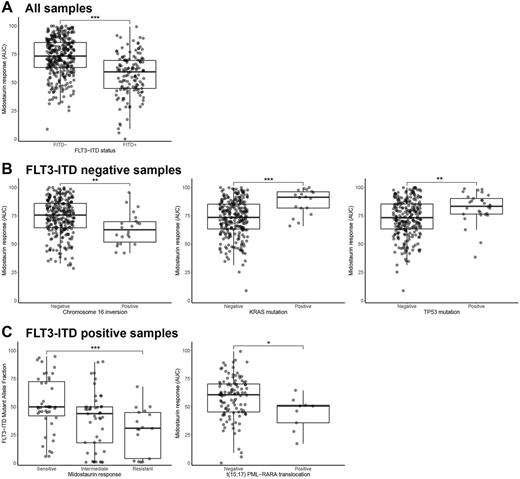Abstract
Introduction: Midostaurin is an FDA approved, multi-target tyrosine kinase(TK) inhibitor shown to inhibit the FLT3 kinase and have therapeutic benefit in FLT3 mutated AML especially FLT3-ITD mutations (FITD+). However, midostaurin has also shown therapeutic response in select FLT3-ITD negative (FITD-) AML patients likely due to inhibitory effects on other TKs .We analyzed primary AML patient samples from our 'Beat AML' database to look at disease related factors, aside from FLT3 status, that may influence midostaurin drug sensitivity and affect patient outcomes.
Methods: We collected peripheral blood and bone marrow samples from 483 newly diagnosed AML patients (348 FITD+, 135 FITD-), extracted mononuclear cells and plated them on a Midostaurin dose curve, without growth media or feeder cells. Metabolic viability was assessed after 72-hours and drug response was summarized with an area under curve (AUC) metric on a 0-100 scale. We annotated these samples for known chromosomal translocations and somatic mutations in leukemia-related genes and performed association-based analyses to identify genomic predictors of midostaurin drug sensitivity.
Results: FLT3-ITD was predictably the strongest association with midostaurin-response, so further analysis was subsetted into FITD+ and FITD- samples (Figure A). For our analysis, we included FLT3-TKD mutant samples in the FITD- cohort as we found no significant difference between FLT3-TKD status and non-FLT3 mutated samples.Within FITD- samples, we found inv(16) Core Binding Factor AMLs demonstrated increased sensitivity to midostaurin (p < 0.05) . We investigated the frequency of c-Kit mutations in inv(16) AMLs, given Midostaurin's activity against c-Kit, but did not observe significant differences in drug response between any combination of inv(16) and c-Kit mutational status due to a relatively small sample size.(Fig B) Further, among all FITD- samples evaluated, we found mutations in KRAS and TP53 to be predictive of midostaurin resistance (p < 0.05, Fig B). This relationship was also observed through analysis of publically available cell line drug screens within the Genomics of Drug Sensitivity in Cancer (GDSC), where mutations in NRAS and TP53 suggested Midostaurin resistance.
In FITD+ AML samples, we found the FLT3-ITD mutant allele fraction (MAF) to strongly correlate with the extent of Midostaurin sensitivity. FLT3-ITD MAF was significantly higher in Midostaurin-sensitive samples compared to resistant samples (p < 0.001)(Fig C). Additionally, we observed an increase in Midostaurin efficacy (p < 0.05) in FLT3-ITD positive(15;17) APL,a subset of APL with relapse rates 15-times higher than FLT3 WT APL (Breccia et. al. Haematologica 2013) (Figure C). Further, we found that neither NPM1 or FLT3-TKD status conferred additional sensitivity to Midostaurin. There was no significant difference in AUC between FLT3-ITD and NPM1 double-mutant samples and FLT3-ITD alone, and similarly no significant difference between FLT3-TKD and FLT3 WT samples.
Discussion: With the approval and clinical use of Midostaurin in FLT3 positive AML patients it is important to find and validate factors influencing Midostaurin efficacy. Data from the RATIFY clinical trial has shown Midostaurin improved overall survival in patients with both high and low FLT3-ITD allelic ratios (Stone et. al. N Eng J Med 2017). We show that the ex vivo Midostaurin response is correlated with FLT3-ITD status and its MAF but not significantly with the FLT3-TKD mutation. Our data suggests that FITD+ APLs are responsive to this FLT3-inhibitor thus offering the potential of combination therapy and improved outcomes with current APL regimens.We also demonstrate that Midostaurin shows efficacy in FLT3-ITD negative patient samples, illustrating the multi-targeted nature of the inhibitor. Within these samples,inv 16 predicted Midostaurin sensitivity regardless of c-Kit mutational status. Additionally, mutations in TP53 and the Ras-pathway predict Midostaurin resistance (these mutations rarely co-occurred with FLT3-ITD in our cohort, thus limiting their impact in FLT3-ITD positive cases). Additional in vitro and clinical data is necessary to determine whether these findings should influence treatment decisions.Newer FLT3 inhibitors in clinical trials need to be characterized in a similar manner so as to efficiently target subsets of FLT3 mutated AML.
Tyner: Takeda Pharmaceutical Company: Research Funding; Constellation Pharmaceuticals: Research Funding; Incyte Corporation: Research Funding; Janssen Pharmaceutica: Research Funding; Array Biopharma: Research Funding; Aptose Biosciences: Research Funding; Syros: Research Funding; AstraZeneca: Research Funding; Genentech: Research Funding; Agios Pharmaceuticals: Research Funding; Seattle Genetics: Research Funding; Gilead: Research Funding; Leap Oncology: Consultancy. Borate: Novartis, Jazz: Consultancy, Speakers Bureau.
Author notes
Asterisk with author names denotes non-ASH members.


